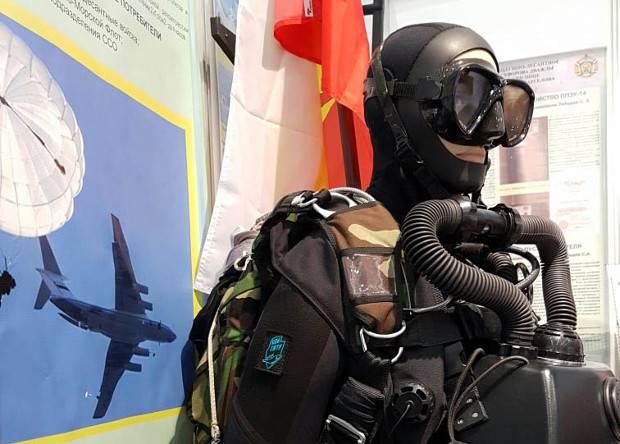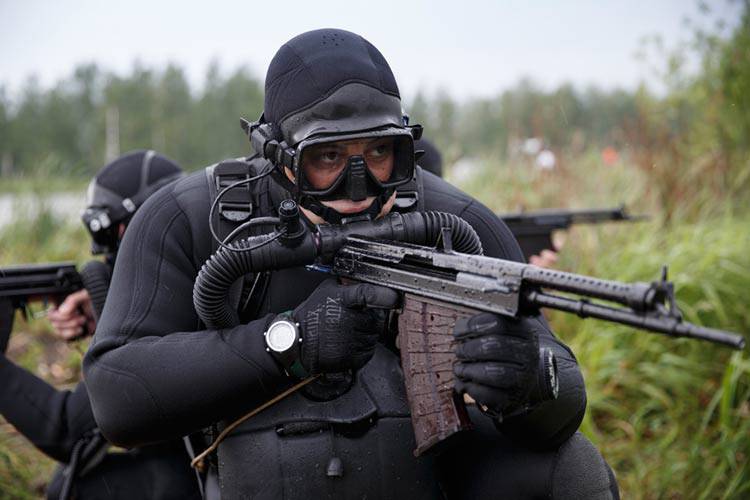Russian special forces will receive a two-medium breathing apparatus
Until recently, all Russian special forces in the implementation of complex tasks with the implementation of the landing from a great height needed to wear a special breathing apparatus at high altitude, as well as scuba gear. After landing on the water, the special forces changed their masks and switched off the flow of the breathing mix before committing the dive. With the advent of the DA-21Mk2D rebreather, the need to switch the supply of breathing gas has disappeared. In addition, thanks to the new breathing apparatus, the composition of the outfits of the Russian fighters can be reduced. The new two-medium breathing apparatus was designed jointly by the St. Petersburg State Maritime Technical University (SPbGMTU) and the Ryazan Higher Airborne Command School (RVVDKU).
The mass of the DA-21Mk2D is approximately 10 kilograms. It is designed for normal operation at ambient temperatures from –2 to + 30 degrees Celsius. In rezibera enough breathing mix for continuous operation for four hours. New two-medium breathing apparatus refers to the apparatus of a closed loop. YES-21Mk2D was equipped with a special capsule with calcium hydroxide. It is through it that the air exhaled by the special forces soldier passes. Calcium hydroxide absorbs carbon dioxide from exhaled air to form calcium carbonate. Then the air, purified from carbon dioxide, is enriched with oxygen and re-enters the soldier's respiratory mask.

The first rebreather in the Soviet Union, designed specifically for parachutists, appeared in the first half of the 1970-s. The device received the designation IDA-71P. This device is designed to perform diving from a small height at which the special forces can do without an oxygen mask. Nowadays IDA-71P is in service with divers and reconnaissance swimmers. The device belongs to regenerative rebreathers, in this breathing apparatus, in addition to the usual carbon dioxide absorber, a special regenerative substance based on sodium peroxide is used. This substance not only successfully absorbs carbon dioxide, but also emits oxygen, which is then mixed into the purified air. The implementation of such a scheme reduces the oxygen consumption from the cylinder.
Tests of the YA-21Mk2D breathing apparatus are to be held in the summer of 2017 in the Crimea. They are planned to be held at the base of the training center of the Special Operations Forces (SSO), Izvestiya reports with reference to representatives of the Russian military department who are familiar with the test plans. Currently, a new two-medium respiratory system is undergoing underwater tests, which according to plans should be completed at the end of 2016 - the beginning of 2017 of the year. After that, the system will be tested at an altitude of 10 thousands of meters. Directly in the Crimea, the command of special operations forces will be engaged in a comprehensive inspection of the apparatus, with the accomplishment of long parachute jumps into the water.
According to Alexei Blinkov, head of the department for defense research and development, a unique two-medium breathing system was developed on the basis of the DA-21Mk2 complex, which is already in service with the Russian fleet. In the new version, the device, which received the prefix "D" ("landing"), was substantially modified. So, according to the requirements of the military, the mount of the device was transferred to the chest. This is done so that the paratrooper could carry a two-medium breathing apparatus along with a parachute pack. Also, the apparatus was significantly lightened, its mass decreased by more than two times - from 21 to 10 kilograms due to the use of modern composite materials and the refusal to supply a nitrogen-oxygen mixture in favor of ordinary oxygen. According to Alexei Blinkov, commandos also perform tasks underwater at a depth of 20 meters. In this regard, after consultations with the military, we decided to refuse the use of nitrogen-oxygen mixture, which is not intended for breathing at high altitude.

“Under normal conditions, combat swimmers are delivered to the site of sabotage on submarines and ships,” notes military expert Vladislav Shurygin. “However, in the presence of hydroacoustic barriers, modern coastal defense radar stations and patrols, it is not always possible for submarine saboteurs to penetrate the necessary area in the traditional way. It is for this reason that a system has developed in the world today, when special forces fighters make long-lasting high-altitude jumps with a landing in the water, and only then proceed to the solution of the tasks assigned to them, including going ashore.
It must be remembered that the equipment that combat swimmers use today is very different from the usual for all people familiar with diving, cylinders with compressed air and oxygen. Such containers would occupy a lot of space on the human body. In addition, they have a rather unpleasant factor - the air that is exhaled from the lungs, through the valves gets into the water in the form of bubbles, which unmask the swimmer. At the same time, closed loop devices (rebreathers) are much more compact, and their work is based on a different principle - oxygen is not stored in a separate container, it is generated using a chemical reaction. At the time of expiration, the air from the swimmer’s lungs, in which the carbon dioxide content is increased, and the oxygen content opposite is lowered, is sent to a special tank, in which there is a regenerating element, which absorbs carbon dioxide. Subsequently, the oxygen-enriched mixture enters the inhalation channel again. The device is able to provide the possibility of breathing under water for several hours, and this time period is calculated taking into account the fact that the commando will actively move, while consuming much more oxygen.
In addition to compactness, all rebreathers have another important advantage: closed-loop vehicles almost do not emit bubbles into the water. Of course, some of the swimmer’s exhalation is released through a special valve, but it is so small that no air bubbles are observed on the surface of the water that could unmask the special forces soldier and disrupt the fulfillment of the combat mission.
Information sources:
http://izvestia.ru/news/639512
https://nplus1.ru/news/2016/10/24/rebreather
http://www.utro.ru/articles/2016/10/25/1302166.shtml
Information